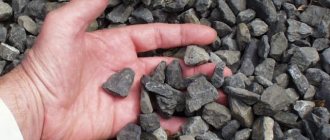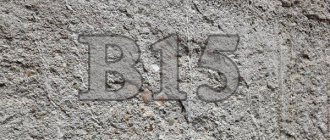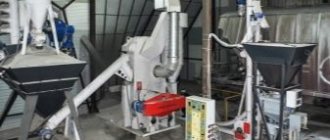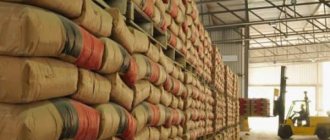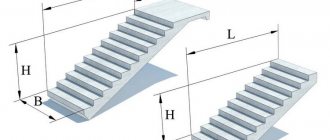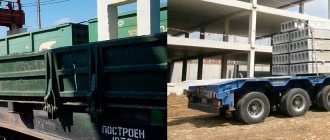Types of crushed stone
The production of inorganic concrete aggregate includes 2 stages of processing: crushing, sorting of rocks, solid construction waste, metallurgy.
Building materials are classified according to the origin of raw materials, fractional composition, and other features. The main types of construction crushed stone are as follows.
Granite
The rock is separated from the rock mass by an explosion and transported to the crushing and screening complex - DSK. Requirements for stone processing products are established by the GOST 8267-93 standard - construction crushed stone and gravel from dense rocks. Characteristics:
- fractions – from 5-10 to 70-12 mm;
- strength grade – 800-1600;
- frost resistance – 300-400.
The color of granite breccia depends on the color of the grains of its constituent minerals: feldspar (pink), quartz (white), mica (from transparent to black).
Shades change from gray to pinkish.
Gravel
What has been said about crushed granite applies equally to this type of concrete aggregate, excluding strength grades - it does not exceed M1200.
The difference lies in the method of obtaining raw materials for production: gravel - rounded individual rocks destroyed by nature. Small pebbles are sifted without crushing, and boulders are passed through a crusher. The rounded edges of the stone make the concrete based on it less durable.
Limestone
It is made from carbonate rocks, which explains the restriction on use in critical structures made of concrete. You can identify crushed stone by the following indicators:
- color – from white to light gray;
- dusting during loading and unloading;
- maximum size – 40-70 mm.
A variety is dolomite aggregate. The main advantage is an affordable price with good strength and frost resistance.
Secondary
Produced in accordance with GOST 25137-82 for dense sand and crushed stone from industrial waste. For production, fragments of destroyed concrete and brick structures are used. Peculiarities:
- strength – up to M800;
- resistance to freezing – 150 cycles;
- price – 30% of the cost of granite aggregate.
Construction waste is processed into crushed stone at the DSC for crushing rocks. Types of crushed stone are also classified by size.
By factional composition
The crushed raw material mass is fed to a system of screens with cells of a specified size. Sieving is carried out into fractions - the limits of the dimensions of individual stones. By size, crushed stone is divided into 3 groups:
- Fine aggregate – up to 20 mm. Product line: 3-8 (euro crushed stone), 5-10, 10-20, 5-20.
- Average crushed stone: 20-40. The most popular variety.
- Large bulk - 25-60, 40-70. They can be raw materials for the production of the first two materials.
Non-fractional (0-20, 0-40, 0-60) and rubble stones - 40-300 mm - are highlighted separately. In construction, 5-20, 20-40 and 40-70 mm are most often used.
Other classifications
The first sign of what type of crushed stone there is is the scope of its application. The main use of crushed stone is construction.
A smaller part of aggregate production volume is decorative crushed stone. To make it, rocks with minerals of different colors are selected.
What is the difference between crushed stone and gravel?
Crushed stone
The main difference between these materials is their origin. Crushed stone is obtained artificially by crushing rocks, while gravel is formed during natural processes. As a rule, this takes a lot of time. The rate of formation of crushed stone is incomparably higher and is determined by the strength of the rock and the power of the mechanisms for crushing it. We can say that gravel has a historical past, while crushed stone has practically none.
Sharp angular edges and the presence of numerous protrusions also distinguish crushed stone from gravel. These properties provide better adhesion to the cement mass than river gravel, which makes it more preferable for construction. But its decorative qualities are lower.
The composition of crushed stone may be the same as that of gravel, or it may differ. It all depends on what material the crushed stone was made from. If it is a natural rock, then the composition will be similar (i.e. natural). However, crushed stone can also be produced from industrial and construction solid waste: ceramics, slag, etc. The mineral composition of crushed stone obtained from rocks depends entirely on their composition. It can be obtained from rocks of igneous origin (granite, basalt, etc.), metamorphic (marble, gneisses, etc.), sedimentary (dolomite, limestone).
Technical properties
The quality of concrete is influenced by the characteristics of its components: cement grade, parameters of fine and coarse aggregates. In preparing the mixture, the selection of bulk materials by fraction, strength, and frost resistance of crushed stone are important. GOST also normalizes the level of radioactivity - for granite stones it can be increased if an appropriate survey of the quarry has not been carried out.
Frost resistance
Ability to withstand sudden temperature changes without losing strength. It is designated by the symbol F and a number – the number of test cycles passed. Types of crushed stone according to resistance to frost-thawing:
- high degree of protection – F200-400;
- resistant – F50-150;
- unstable – F15, F25.
Most construction concrete work is carried out using F300 grade aggregates.
Strength
Granite crushed stone is the leader in this indicator - it can withstand a load of 1600 kg/cm². The characteristic is designated by the letter M, in this case – M1600. Strength grades of aggregates:
- M200 – very weak crushed stone;
- M300-600 – weakened;
- M600-800 – medium strength;
- M800-1200 – durable;
- M1200-1400 – high strength;
- M1400-1600 – heavy-duty.
The most in demand are granite and basalt aggregates M1200.
Radioactive properties
We are talking about the specific activity of radionuclides. According to this characteristic, crushed stone is classified into the first or second class of radiation radiation.
Safer - I class, which is assigned to the filler with a specific efficiency <370 Bq/kg, and II class. allows higher levels of radioactivity: <740. Crushed stone of the second class is used only for filling the road surface.
Why is there crushed stone in concrete?
As already mentioned, crushed stone is an inert aggregate that makes up the frame of a concrete stone.
Sand fills the voids between the grains of crushed stone, and cement, reacting with water, binds this entire structure.
If we remove crushed stone from the composition, then such a structure will be subject to shrinkage. It helps to increase strength, but only on the condition that its strength characteristics are approximately 2 times higher than the grade of cement. Moreover, there is more crushed stone in concrete relative to all other components. Average formula of concrete mixture by mass:
Cement/sand/crushed stone/water = 1:2:4:0.5.
As you can see, crushed stone occupies the main space.
Areas of application
The variety of types of aggregates is determined by the numerous areas of use of fractionated stones. No construction begins without stockpiling bulk materials. Here are just a few types of industries using crushed stone:
- Laying of railway tracks. GOST R 54748-2011 for the formation of a ballast base under sleepers prescribes the use of fractions of 30-60 and 25-60 mm.
- Creation of a filtration cushion when arranging foundations. To do this, take crushed stone 20-40.
- Production of reinforced concrete, rings, blocks and panels from it. Common sizes of stones are 3-8, 5-20, 20-40.
- Landscape design. Large stones and boulders are used to build fences and lay out paths. Fine gravel decorates flower beds and alpine slides.
- Limestone crushed stone is used in metallurgical production, glass industry, and cement production. White color determines its use in landscaping.
Recycled crushed stone, due to its low cost, allows you to reduce the cost of building foundations. Foundations for pipelines and other structures are poured from it.
What types of crushed stone are used in concrete production?
Depending on the source raw material, the following types of crushed stone are distinguished:
- Gravel.
- Granite.
- Limestone.
- Artificial.
Granite aggregate has the best consumer characteristics, which has maximum strength, which is especially important in the production of concrete mixtures. The unrounded rough surface of this non-metallic material adheres well to a mixture of sand and cement.
offers supplies of any volumes of non-metallic materials, including crushed stone with fraction sizes from 3*10 to 40*70. From us you can also purchase any brand of concrete for your current needs. We have set extremely low prices for crushed stone and are ready to deliver the batch as quickly as possible throughout Moscow and the Moscow region! We invite you to familiarize yourself with the current price list and place your order without wasting time:
| Heavy concrete (gravel) | Heavy concrete (granite) | ||
| Name | price, rub. per 1 m3 without PMD | price, rub. per 1 m3 without PMD | PMD, rub. |
| Concrete M-100 | 3203 | 3802 | 100 |
| Concrete M-150 | 3351 | 3913 | 100 |
| Concrete M-200 | 3405 | 4050 | 100 |
| Concrete M-250 | 3604 | 4150 | 150 |
| Concrete M-300 | 3702 | 4352 | 150 |
| Concrete M-350 | 3804 | 4351 | 150 |
| Concrete M-400 | 4000 | 4552 | 200 |
| Concrete M-450 | — | 4754 | 200 |
| Concrete M-550 | — | 5000 | 200 |
Answers on questions
Private developers are often interested in the characteristics of crushed stone. Here are clarifications for some queries:
- Lime filler when pouring the foundation. This is possible provided that its characteristics of strength and size match. It is necessary to maintain the proportions of other components of the mixture: sand, cement, additives.
- Weight of a cubic meter of crushed stone. Taking into account the conversion factor, the fine fraction will pull 1.4 tons, the large fraction – 1.3.
- Select material for filling the road to the garden plot. It is recommended to use broken bricks or recycled aggregate and sprinkle it with asphalt chips.
There are also non-essential questions: the differences between crushed stone and crushed stone. The answer is there is no difference.
Extraction, production, composition, characteristics and more
Crushed stone is a fractional material obtained by grinding large pieces of rock, the extraction of which is carried out in accordance with various technologies, using several types of equipment. Extraction of feedstock is not always required. For the production of so-called secondary types of crushed stone, not fragments of rocks are used, but waste from construction and the metallurgical industry . In these cases, manufacturers immediately proceed to processing raw materials, which is carried out by crushing and sorting (screening) into fractions.
Splitting up. Photos of Soil Trucks
The screening process allows us to determine the grain composition, which is similar for different types. But the chemical and mineral compositions, as well as characteristics, depend on the type and properties of the feedstock.
Crushed stone has several characteristics: flakiness, frost resistance, strength, density and compaction coefficient, specific gravity and others. However, the indicators for different species differ. It is these parameters, as well as the type of material, that determine the purpose.
7. Transportation and storage
7.1 Crushed stone and gravel are transported in bulk in vehicles of any type in accordance with the current rules for the transportation of goods and technical conditions for loading and securing goods, approved by the Ministry of Railways, rules for the transportation of goods by road and water transport. When transporting crushed stone and gravel by rail, wagons should be loaded taking into account the full use of their carrying capacity.
7.2 Crushed stone and gravel are stored separately into fractions and mixtures of fractions under conditions that protect them from clogging and contamination.
Determination of dust and clay particles content
This is an important indicator that directly affects the strength characteristics of concrete. Clay particles end up in crushed stone if it is made from gravel rather than from sedimentary or volcanic rock. In addition, dust is formed during crushing and its mass is regulated by GOST.
Dust and clay particles form extensive surface shells that interfere with the adhesion of cement and aggregate. They require increased consumption of cement in order to bind this entire surface. Moreover, it is necessary to increase the water consumption, which also leads to a loss of final strength.
The content of dust and clay particles is determined by the elutriation method. Pipette and wet sieving methods are also used. They are described in detail in GOST 8269.0-97 (Chapter 4.5). The content of dusty clay inclusions for crushed stone should not exceed 1 - 3% by weight (GOST 8267 - 93).
Rubble stone, dimensions
Rubble stone is a name given to fragments of natural material of large size and irregular shape. In most cases, they are characterized by an uneven shape of the edges, various dimensions and qualities, differing depending on the chemical and physical composition and origin.
Types of buta stone
The classification and scope of application is determined according to the content of the regulatory GOST 4001-2013, which calls this type of crushed stone wall stone. Division by factions is not used in this situation. Here, a different, individual characteristic is applied, prescribed in paragraph 3 of the above standard and dividing them into 2 groups:
- Volumetric, divided into 2 groups: Dimensional facing - intended for laying external walls and characterized by a certain surface texture. Measured rows - having different shapes and used for laying internal walls.
- Tiled, made in the form of slabs or strips with edges cut off or chipped off on one side. They are classified into processed and unprocessed (natural).
The main dimensions of measuring stones according to GOST 4001-2013
Rubble stone is used in the construction of walls of unheated buildings, fences, hydraulic structures, arrangement of foundations and foundations of buildings.
An example of the use of decorative crushed stone
Flakiness or shape of crushed stone
The plastic or needle-shaped shape is characterized by the presence of flat, even edges. Cuboid shape is stones with conditionally equal sides.
A high content of lamellar and needle-shaped grains in crushed stone indicates a higher flakiness. The more angular and finer the particles, the less flakiness.
According to the degree of flakiness, crushed stone can be:
- usual
- flakiness 25-35%, - improved
– flakiness 15-25%, - cuboid
– flakiness less than 15%.
High flakiness increases gaps and creates unnecessary voids, so ordinary crushed stone is not recommended for use in the construction of high-traffic roads and in the production of concrete mixtures. To do this, it is better to use cube-shaped crushed stone, which will allow for dense compaction.
The smaller the size of the crushed stone, the less important is its flakiness, because small grains are always compacted well.
A little more about dropouts
Crushed stone, the types and characteristics of which are of interest to many builders, is presented for sale in the form of screenings. According to some characteristics and scope of use, crushing waste is close to the described recyclable materials. However, it should be remembered that these materials are completely different, and their difference is that sand screenings have a larger number of foreign inclusions. It may contain large stones up to 100 mm and very fine sand, which limits the scope of use of such raw materials.
Scope of application of crushed stone screening
The use of crushing screenings is varied. They are used in agriculture, construction, printing and in the improvement of personal gardens. Like gravel, granite screenings are used for finishing, when casting curb stones and tiles, as follows from consumer reviews. Without losing quality, they can replace gravel in concrete, reducing the cost of the material. Raw materials from limestone processing waste are used as a filler for cement-based solutions, which are used for wall cladding.
What is gravel
Gravel is a sedimentary rock of mountain origin, the composition of which is very heterogeneous. In nature you can find different types of gravel, ranging from mountain gravel to sea gravel. This feature of this material greatly influenced its physical and mechanical properties; each type of gravel has its own.
Gravel is extracted using special equipment. After transportation, the material undergoes careful calibration, during which the gravel is screened by size. In some cases, if production requires it, the gravel is washed to remove clay, sand and various other inclusions.
Based on the fraction, there are three types of gravel:
- Gravel measuring 1-1.25 mm is considered fine;
- Sizes up to 5 mm are considered medium;
- Gravel over 10 mm is considered coarse.
Since this inert material is mined in different places, there are several varieties.
Types of gravel
Mountain gravel differs from other types of gravel in its rough and sharp surface with a large inclusion of various impurities. Today, mountain gravel is most widely used in road construction.
River gravel has a smooth surface and rounded shapes. During the production process, river gravel is often crushed to increase its adhesive properties. This is the most popular type of gravel, which is distinguished by its strength, both in crushability and frost resistance.
Sea gravel - this type of gravel differs from all others in its polished surface and minimal amount of foreign inclusions.
In addition, gravel differs depending on the application. For example, there is decorative gravel, which is widely used in landscape design, and white gravel, which allows not only to decorate the local area, but also to slow down the growth of weeds in flower beds.
Properties of gravel
Gravel has good density and compressive strength. In addition, the excellent frost resistance of this material should be highlighted.
Below are the main physical and mechanical properties of gravel:
- Compressive strength, not less than 1.5 t/cm2;
- Frost resistance F15-F200;
- Gravel density, from 1.4 to 3 g/cm3;
- Weight, 1400 kg per cubic meter;
- Fraction size, from 3-150 mm.
Gravel is considered one of the most durable inert materials, which is widely used in construction.
Density and strength of crushed stone
The density of crushed stone ranges from 1.2 to 3 g/cm3 and strongly depends on the type of origin of the material. The higher the density, the more versatile the material is. The density and strength of crushed stone are directly proportional indicators.
Strength is the ability of a material to withstand mechanical loads of various types. Research and determination of the strength grade are carried out through a series of tests, checking crushed stone in a cylinder, shelf drum and compressing it. Such experiments make it possible to simulate real conditions of future operation. According to the strength grade, crushed stone ranges from M200 to M1600 (the numerical indicator means the maximum withstand load in kg/cm2) and is divided into the following classes:
- M200 – crushed stone of very weak strength, used for arranging drainage systems and creating unloaded backfill;
- M300-M600 – low strength crushed stone, used in the same areas as M200 crushed stone;
- M600-M800 – medium-strength crushed stone, can be used to create unloaded structures, for example, non-load-bearing walls;
- M800-M1200 – durable crushed stone, the most versatile option, which is used to create foundations, load-bearing walls, supports, fences, etc.;
- M1200-M1400 – high-strength crushed stone, without which it is impossible to build the foundation of a multi-story building, bridge supports and hydraulic structures;
- M400-M1600 is a heavy-duty crushed stone that is used quite rarely and only when creating especially critical structures.
Crushed stone of weak strength (M200), used in the construction of drainage systems.
In crushed stone, the amount of impurities of weak rocks , because the strength of the material directly depends on this. To determine this parameter, tests are carried out and a pressure of 20 MPa is created on the crushed stone. According to GOST 8267-93, some of the impurities of low-strength rocks are standardized as follows:
- for crushed stone M1600 – no more than 1%;
- for crushed stone M1000-M1400 – no more than 5%;
- for crushed stone M400-M800 – no more than 10%;
- for crushed stone M200-M300 – no more than 15%.
If the content of low-strength impurities is more than 20%, then the material is called gravel and is used only in non-critical work, for example, when creating temporary structures, filling local roads, etc.
